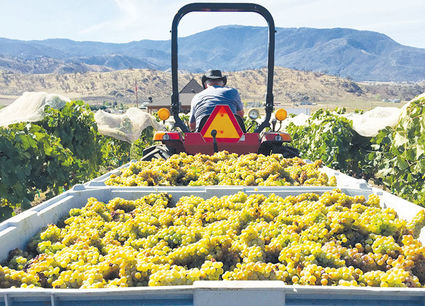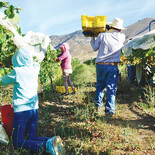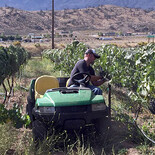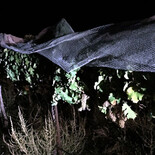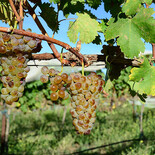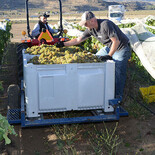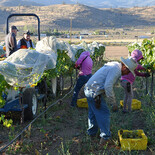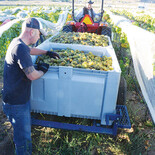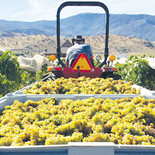Harvest activities at Triassic
It should be no surprise that the harvest moon shone down as the first Triassic crop of 2015 (Viognier) began its journey from vine to bottle the last weekend of September. The earliest members of the harvesting crew started at 7 p.m. Saturday and continued at 5:30 a.m. Sunday, using headlamps to augment the moon's glow while they removed the netting in anticipation of the arrival of the pickers.
This is the first year that Triassic has used the netting to prevent extensive damage from the starlings, a flocking bird considered a pest by field farmers. Their large numbers can cause destruction of entire crops. With Tehachapi's late harvests, the birds flock in around late summer to feast on unprotected fields.
According to proprietor Jim Arnold, Triassic saw an increase in bird numbers in the past weeks as farms and vineyards in other areas of California completed their harvests earlier than the typical Tehachapi climate allows. Only one of the crops at Triassic was affected by the starling invasion, as the other two, including the Viognier harvest, had nets already in place. The third crop, the Zinfandel, received a quick application of netting as soon as the invasion began. (The Arnolds had hoped a scent deterrent would work, but found the huge numbers of birds could do quick damage in a short amount of time despite its efficacy). Many Triassic fans will be disappointed to learn that almost half of the Zin crop was lost to bird damage, but ... a very valuable lesson was learned and future yields will benefit.
Net uncloaking was performed during the twilight, night and dawn hours when the starlings were bedded down. The work involved removing clips and draping the nets high on the plants to give the harvesting crew access to the grapes that drooped below. Once they arrived just before sunrise, the pickers (who specialize in grapes and have spent the last 1-1/2 months harvesting grapes on almost a daily basis) were able to quickly bring in the nearly five tons of fruit in just under six hours. Crew Chief Fermin told this reporter that his crew does everything related to grapes – from planting to harvest. This specialization showed in their incredible mastery of grape harvesting. As a former worker with blueberries (seven summers working a farm), this reporter found the speed and incredible adeptness of the crew impressive.
Soon after completion of the Viognier harvest, the starlings began their dance of flight over the crop, only to be disappointed by the lack of fruit. The only thing left on the plants were the very few clusters of unripe grapes left behind by the pickers. The adjoining crops of Zinfandel and Syrah remained protected by their netting.
Winemaker Steve Lemley, of Pulchella Winery, was on hand during the operation. He also commented on the swiftness and thoroughness of the work. His estimate of five tons proved very accurate, although early on he was concerned it could turn out to be low. With 45 rows to harvest and 10 bins to fill, the first hour's yield of two full bins before completion of eight rows raised enough concern to spur him to call his partner in Valencia and put him on hold to bring up two additional bins should it prove necessary. In the end, it didn't; and his original estimate proved to be the accurate one. As he laughingly stated, "This isn't my first rodeo."
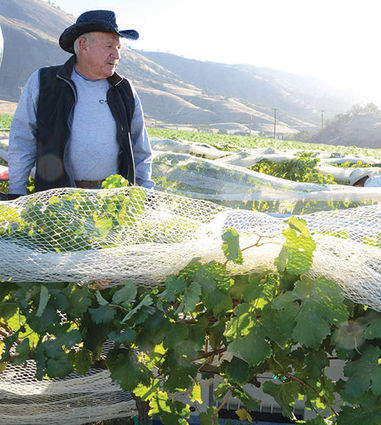
Nick Smirnoff (NPPA)
Only one of the crops at Triassic was affected by the starling invasion, as the other two, including the Viognier harvest, had nets already in place. Pictured is proprietor Jim Arnold just before the harvest.
During the harvest of the Viognier, Steve took the opportunity to grab samples from both the Syrah and the Zinfandel crops to take back to the winery for testing. To do this, more than 20 samplings were taken from the crops in various locations of a grid pattern, and the grapes were crushed together and tested. One of the measurements looked at was brix, the intensity of sweetness that shows whether a grape is at the right level of ripeness (the goal is 24-26 brix for the wines of Triassic).
The test results helped Steve work with Jim to determine the upcoming steps and the best date for harvest of the final crops. So many factors weigh into how the brix and other grape qualities are influenced by the watering, soil, weather patterns, etc., and the exact date (the first Sunday of October) was worked out between Jim and Steve as they tested the grapes' readiness based on their desired qualities.
Listening in on the dialogues and exchanges between this winemaker and vineyard proprietor, one can't help but be impressed by the amount of skill and dedication needed to become a master of the art of winemaking. It's no wonder that their wines have such great flavor and texture. This reporter looks forward to the new Triassic vintages coming our way!

